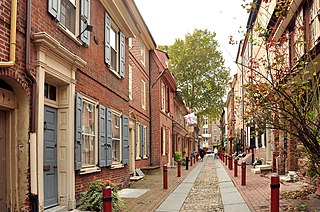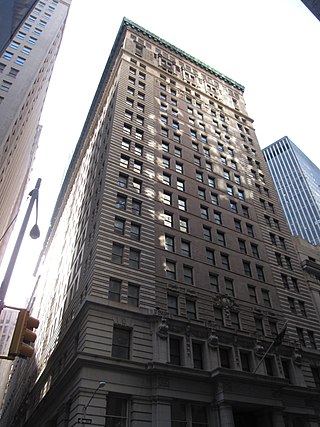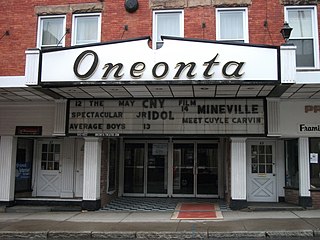
The Financial District of Lower Manhattan, also known as FiDi, is a neighborhood located on the southern tip of Manhattan in New York City. It is bounded by the West Side Highway on the west, Chambers Street and City Hall Park on the north, Brooklyn Bridge on the northeast, the East River to the southeast, and South Ferry and the Battery on the south.

Oneonta is a city in southern Otsego County, New York, United States. It is one of the northernmost cities of Appalachia. Oneonta is home to the State University of New York at Oneonta and Hartwick College. SUNY Oneonta began as a normal school and a teacher's college in 1889, and Hartwick College moved into the city in 1928. The approximately 5,800 students from SUNY Oneonta and the approximately 1,500 students at Hartwick make up a significant percentage of the population of Oneonta. According to the 2020 U.S. Census, Oneonta had a population of 13,079. Its nickname is "City of the Hills." While the word "oneonta" is of undetermined origin, it is popularly believed to mean "place of open rocks" in the Mohawk language. This refers to a prominent geological formation known as "Table Rock" at the western end of the city.

The Meatpacking District is a neighborhood in the New York City borough of Manhattan that runs from West 14th Street south to Gansevoort Street, and from the Hudson River east to Hudson Street. The Meatpacking Business Improvement District along with signage in the area, extend these borders farther north to West 17th Street, east to Eighth Avenue, and south to Horatio Street.

This list is intended to be a complete compilation of properties and districts listed on the National Register of Historic Places in Rensselaer County, New York, United States. Seven of the properties are further designated National Historic Landmarks.

Sunnyside Gardens is a community within Sunnyside, a neighborhood in the New York City borough of Queens. The area was the first development in the United States patterned after the ideas of the garden city movement initiated in England in the first decades of the twentieth century by Ebenezer Howard and Raymond Unwin, specifically Hampstead Garden Suburb and Letchworth Garden City.

Historic districts in the United States are designated historic districts recognizing a group of buildings, archaeological resources, or other properties as historically or architecturally significant. Buildings, structures, objects, and sites within a historic district are normally divided into two categories, contributing and non-contributing. Districts vary greatly in size and composition: a historic district could comprise an entire neighborhood with hundreds of buildings, or a smaller area with just one or a few resources.

55 Central Park West is a 19-floor housing cooperative on the Upper West Side of Manhattan in New York City. Built in 1929, it was designed by the architectural firm Schwartz & Gross. The building is a contributing property within the Central Park West Historic District, which is listed on the National Register of Historic Places.

The Langham is a luxury apartment building located at 135 Central Park West on the Upper West Side of Manhattan, New York City. After the site was unused for more than 15 years, the building was constructed between 1905 and 1907. Built at a cost of US $2 million, the structure included modern amenities, such as ice accessible from every apartment. The building was designed in the French Second Empire style by architects Clinton and Russell. It was listed as a contributing property to the federal government designated Central Park West Historic District on November 9, 1982.

Jewelers' Row, located in the Center City section of Philadelphia, Pennsylvania, United States, is composed of more than 300 retailers, wholesalers, and craftsmen located on Sansom Street between Seventh and Eighth Streets, and on Eighth Street between Chestnut and Walnut Streets.

The East End Historic District in Newburgh, New York, United States is the lower portion of what state and city officials recognize as a single historic district along with the Montgomery-Grand-Liberty Streets Historic District. Its 445 acres (2 km2) contain 2,217 buildings, including Washington's Headquarters State Historic Site, a National Historic Landmark.

Stone Street is a short street in the Financial District of Manhattan in New York City. It runs in two sections between Whitehall Street in the west and Hanover Square in the east. The street originally ran as one continuous roadway from Whitehall Street to Hanover Square, but the section between Broad Street and Coenties Alley was eliminated in 1980 to make way for the Goldman Sachs building at 85 Broad Street. The one-block-long western section between Whitehall and Broad Streets carries vehicular traffic, while the two-block-long eastern section between Coenties Alley and Hanover Square is a pedestrian zone.
Walnut Street Historic District may refer to:

The Broad Exchange Building, also known as 25 Broad Street, is a residential building at Exchange Place and Broad Street in the Financial District of Lower Manhattan in New York City. The 20-story building was designed by Clinton & Russell and built between 1900 and 1902. The Alliance Realty Company developed the Broad Exchange Building as a speculative development for office tenants.

There are 75 properties listed on the National Register of Historic Places in Albany, New York, United States. Six are additionally designated as National Historic Landmarks (NHLs), the most of any city in the state after New York City. Another 14 are historic districts, for which 20 of the listings are also contributing properties. Two properties, both buildings, that had been listed in the past but have since been demolished have been delisted; one building that is also no longer extant remains listed.

Old Post Office is a historic post office building located at Oneonta in Otsego County, New York, United States. It was built in 1915, and is one of a number of post offices in New York State designed by the Office of the Supervising Architect of the Treasury Department, Oscar Wenderoth. The original portion of the building is nearly square, seven bays on each side. It is built of Indiana limestone, with Concord granite trim in the Classical Revival style. It features a giant portico supported by six massive Corinthian order columns. In 1980, the building housed city offices moved from the Old City Hall.

Municipal Building, also known as Old City Hall, is a historic city hall building located at Oneonta in Otsego County, New York. It is three story masonry building with an ornate facade of painted brick and terra cotta, built in 1906 in the Beaux-Arts style. A central tetrastyle pavilion in the Ionic order dominates the upper floors. In 1978 a neocolonial clock tower was erected on the roof. It housed the municipal government until 1980, when they moved to the Old Post Office building.

Oneonta Theatre is a historic theatre building located at Oneonta in Otsego County, New York. The original structure was built about 1897 and expanded in several stages. The original three story structure was a generally rectangular block with storefronts and theater entrance on the first floor and apartments above. A theater wing projected from the rear was set at a 45-degree angle. In 1922, the theater was expanded and the entrance relocated to the center of the building. The 1922 marquee was removed in the 1970s.

Oneonta Downtown Historic District is a national historic district located at Oneonta in Otsego County, New York. It encompasses 64 contributing buildings and one contributing site. It encompasses the city's intact commercial and civic core and includes commercial buildings, six churches, the city's historic civil buildings, a few industrial buildings, and a small park. The district includes several separately listed buildings: the Masonic Temple, Old Post Office, Municipal Building, Ford Block, and Oneonta Theatre.

Rossleigh Court, constructed between 1906 and 1907, currently is a rental apartment building located on the northwest corner of 85th Street and Central Park West in the Upper West Side of Manhattan in New York City.
This is a timeline and chronology of the history of Brooklyn, New York. Brooklyn is the most populous of New York City's boroughs, and was settled in 1646.






















